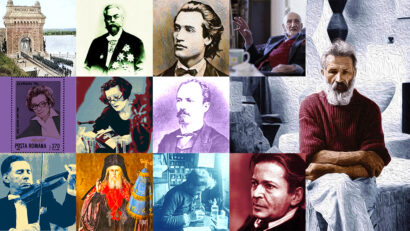Humor in Romanian Literature
Over the centuries Romanians have found great many opportunities to employ various degrees of humor in their day-to-day lives

Christine Leșcu, 21.03.2020, 11:41
Over the centuries Romanians have found great
many opportunities to employ various degrees of humor in their day-to-day
lives. For instance, there have been cities or regions that became the object
of jokes and mockery, so to say. In the second half of the 19th
century and all the way through the 20th century, the town of Mizil
in Prahova County became the target of satire. At the time Romania was
undergoing a thorough process of accelerated modernization, which was hampered
at times. Mizil quickly became the symbol of this rash and often unfulfilled
modernization.
Mizil as the object of mockery also features in literary works,
such as Cilibi Moise’s volumes of witty aphorisms. A Bucharest-based peddler of
Jewish origins, Moses traded in haberdashery in a trading area in Lipscani, the
historical center of Bucharest. Cilibi Moses was illiterate and dictated his
jokes to a typist working for a print shop which eventually released his volume
in 1870, the year of his death.
Publisher Eugen Istodor documented the
humoristic references to Mizil. Here is what he found out about the Jewish
peddler.
Cilibi Moses not only mastered the informal
register, but also discovered his witticism could actually be printed. He therefore
discovered a printer who started releasing his collection of jokes. One of his
famous words of wisdom, passed down over generations, described Mizil as A
large bridge over no water. The description has remained truthful to date.
We’ve recently visited the city, where we indeed found an oversized bridge
extending over a fine stream of water, a striking contrast. We can say,
therefore, this was a joke.
In the early 20th century, many
writers carried over some of the jokes commonly circulated regarding Mizil. In
1900, the great writer I.L. Caragiale, himself born in Prahova County,
published his famous sketch, A Solemn Day. The object was not just Mizil, but
its mayor at the time, Leonida Condeescu, whom the author knew personally.
Eugen Istodor told us more:
It is nearly impossible to think of
Thermopile without immediately associating Leonidas. The same goes for Mizil,
there was no Mizil without Leonida, the same as there was no Leonida without
Mizil. What Leonida Condeescu did for
his folk is impossible to describe in such a limited context. I would just
mention one of his biggest achievements, prompted by his ever burning desire to
highlight the importance of Mizil, to raise Mizil to a position of power and
see the town prosper
And
now the facts. The problem seems to be a far too ambitious Leonida, determined
to solve the historic dilemma of the distance between Ploiesti and Buzau and
more importantly, the problem of Mizil’s status and identity. Leonida does
everything in his power to offer Mizil a status. He even goes to the King for
that, whom he tells: Sire, a lot has been done for other towns and nothing for
Mizil. We do not have a county seat, a tribunal, a bishopric, the 32nd
regiment, a high school, a medical university, a national theatre or a bridge
over the Danube. None of it, Sire! …We are urging you to give us something.
Finally, things are starting
to move. An express train between Bucharest and Berlin, via Breslau is
introduced. Leonida takes a look at the initial itinerary and notices that the
time when the train stops in Mizil is not mentioned. He eventully finds out
that the train does not stop in Mizil at all. After a year of efforts, the
mayor finally obtains something. On May 1st, 1900, train no. 5 from Bucharest
to Berlin and train no. 6 from Berlin to Bucharest stop in the railway station
in Mizil. The white little board
with red letters, indicating the direction of the two extress trains, should read
from now on: Verlin-Bucharest via Breslau-Midil and the other way around,
Bucharest-Berlin via Midil-Breslau.
This is a happy ending that
consolidated the humoristic fame of Mizil, but which jeopardized the friendship
between Caragiale and mayor Leonida Condeescu. The jokes about Mizil became
more frequent in the printed press of the time, with famous journalists such as
Filip Brunea-Fox entering this game during the entire inter-war period. The
avant-garde writer Geo Bogza, himself a talented journalist, wrote about Mizil
in an article published in 1938 and entitled 175 minutes in Mizil, after the number of minutes spent by the
author in the little town, while waiting for a connection train.
Eugen Istodor: Geo Bogza is in fact
suggesting he got bored to death in Mizil and from a moment on he started to
enumerate the things he saw and did there. Here is minute 20: Going back to the square, on foot. A wooden
fence. Minute 23 : Getting to the middle of the square. Doing
nothing. It is like you see Geo Bogza standing still for one minute. It
makes you want to use your stopwatch. Minute
24 : Mizil ! Minute 26 : A dog passes by. Minute 27 : I am
in Mizil. At minute 31, the dog that he had seen passing earlier, at minute
26, passes again, looking bored.
The jokes about Mizil are in fact an irony at
a too ambitious provincial town, which tries to become more important than
allowed by its real status. In time, the place of Mizil was taken, in terms of
mockery, by other towns such as Caracal, Vaslui and Focsani.






























